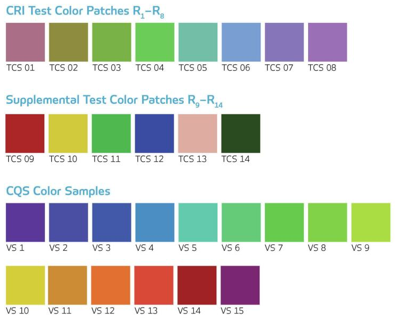Picup your order for free
Provide a more affordable shopping experience

When it comes to choosing the ideal lighting for your specific application, the Color Rendering Index (CRI) is a critical factor to consider, closely linked with color temperature. In this article, we will delve into the intricacies of CRI and offer practical insights to help you make the best choice.
The first portion of this article will provide an in-depth exploration of CRI and the current trends in the industry.
Understanding the Color Rendering Index (CRI)
CRI serves as a straightforward and valuable lighting specification to assess the expected visual quality of a lighting product.
In simple terms, CRI is a numerical measure that ranges from 0 to 100, designed to predict how accurately a product renders colors. The closer the CRI value is to 100, the more faithfully and accurately the colors should appear under its illumination.
However, it's important to emphasize the term "should." CRI is determined based on how well a light source renders eight specific pastel colors. The underlying theory is that if a light source performs well with these colors, it should perform well with all other colors too.
For clarification, consider the example below, provided by the National Institute of Standards and Technology (NIST). It illustrates the difference between poor color rendering light (left) and high-color-rendering light (right). The choice is clear, but remember, this is an ideal scenario.

Some manufacturers go the extra mile by assessing their products with additional color swatches. If you've ever heard of reference to R9, that's a gauge of how well a product should render red colors.
The National Institute of Standards and Technology has also introduced another metric called the Color Quality Scale (CQS), which employs 15 colors to evaluate light quality.
Here are the different swatches used in CRI, R9, and CQS testing:

Advancements in Color Rendering Technology
The landscape of CRI selection has evolved in line with changes in lighting technology. With fluorescent and high-intensity discharge (HID) lighting, selecting the right CRI was relatively straightforward. Moving from a standard to a high CRI came with clear distinctions in price points and product performance.
In contrast, the advent and widespread adoption of LED lighting have created a complex scenario. Selecting the right color and CRI combination can become overwhelming. The reality is that in today's lighting industry, a high-CRI product may not be the magic solution it once was.
Significant progress has been made in addressing this issue, particularly with the introduction of TM-30-15. The Office of Energy Efficiency and Renewable Energy endorses TM-30-15 as a more comprehensive approach to selecting the appropriate lighting product. It combines various metrics to assess the relationship between efficacy and color rendering, aiding in the selection of the best lighting for specific applications.
Another innovative technology, known as "color pumping," has emerged. This technology enhances and enriches the color spectrum, making it especially suitable for retail environments with vibrant products. Manufacturers like Philips, Xicato, and Solais have introduced their own versions, such as "crisp white," "vivid," and "violight."
It's worth noting that CRI can be somewhat misleading in these cases because the objective is to intensify and highlight certain colors (primarily blues, blacks, whites, and greens) rather than replicating a reference source accurately.
A Guide to Choosing the Color Rendering Index
Now, you've invested careful thought into the design of your space, paying attention to surfaces, atmosphere, and products. Alternatively, you might simply need adequate lighting in your space, with less emphasis on color quality, as is often the case in parking garages. How do you determine the right CRI for your needs?
As a general guideline, a CRI of 90 or higher is considered high, while anything below 80 falls into the mid-range to low category. If color quality is a priority, seriously consider a CRI in the 90s.
In other cases, you may need to prioritize factors like light output or wattage, with CRI taking a secondary role in your decision-making.
It's also essential to understand that improving light quality often involves incorporating additional phosphors. As a result, transitioning to LEDs with better light characteristics can lead to a compromise in energy efficiency. In most instances, this trade-off is justified by the benefits of improved lighting quality.
Similar to color temperature, there's no substitute for obtaining samples and placing them in your space to evaluate how they perform. You may find that an 85 CRI product surpasses your expectations, while a 95 CRI product disappoints.
Alternatively, transitioning from low-CRI HID lighting to mid-range CRI LED lighting might reveal a noticeable difference, leading you to consider an upgrade. If you seek lighting that makes retail or gallery displays stand out, you may explore products leveraging the color pumping technology mentioned earlier.
Einen Kommentar hinterlassen